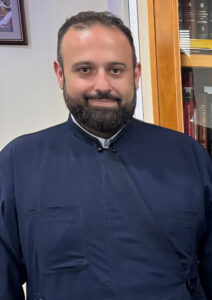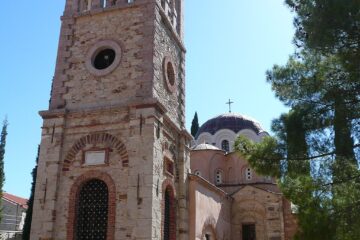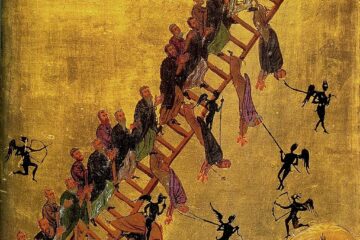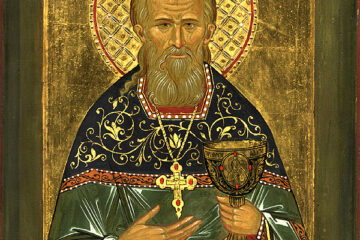By Fr. Michael Psaromatis
Greek Orthodox Archdiocese of Australia
We live in a restless world. Our days are filled with noise, the endless scroll of screens, the pressure to perform, the search for recognition that never satisfies. We are hurried, distracted, pulled in a hundred directions, and yet beneath it all remains a hunger for peace, for something solid and enduring. Into this world the Cross rises, not as a decoration or a relic, but as a sign of stillness, love, and strength. It is the one place where all our restlessness finds meaning and every burden can be laid down.
In every Orthodox church the Cross rises at the centre of our worship. We kiss it, we bow before it, we sign ourselves with it at every moment of prayer. It stands on the holy altar, it hangs in our homes, it rests around our necks. The Cross is not an ornament of the past but the very heartbeat of Christian life. Saint Paul wrote to the Corinthians, “We preach Christ crucified, to the Jews a stumbling block and to the Greeks foolishness, but to those who are called, Christ the power of God and the wisdom of God” (1 Corinthians 1:23–24). What seemed foolishness has become the key to wisdom. What looked like weakness has revealed the greatest strength. The Cross is the paradox of God’s love: life through death, strength through weakness, victory through sacrifice.
The Cross is planted in the midst of the Divine Liturgy, traced upon our bodies in every blessing, and engraved in the heart of every believer as the way of salvation. The hymn of the feast declares: “O Lord, save Your people and bless Your inheritance. Grant victory to the faithful over their adversaries, and protect Your commonwealth by the power of Your Cross.”
Every person carries a cross. Some bear illness, others the weight of family struggles, others the loneliness of rejection or the burden of injustice. The world tells us to escape suffering with distraction or indulgence, to numb the pain through possessions, pleasures or busyness. Yet Christ teaches us something different. He does not promise to remove every burden but He calls, “If anyone would come after Me, let him deny himself and take up his cross daily and follow Me” (Luke 9:23). The Cross is not only the wood of Golgotha but the personal crosses that each of us carries.
A woman undergoing chemotherapy makes the sign of the Cross before each session, whispering “Lord have mercy” as the needle enters her arm. A father working two jobs to keep food on the table kisses the Cross around his neck before leaving for his night shift. A widow lights a vigil lamp beneath the Cross in her home every evening, entrusting her grief to Christ. When our struggles are united to Him they are no longer meaningless but become participation in His redeeming love.
The martyrs bore this truth in blood, but it is also revealed in the quiet perseverance of a mother caring for her sick child, in the patience of a worker enduring hardship without losing faith, in the courage of a believer who forgives an enemy. During Holy Week the Church chants, “Behold, through the Cross joy has come into all the world.” Joy does not mean the absence of suffering but the transformation of suffering into communion with Christ. The Cross teaches us that no pain is beyond God’s power to transfigure.
What looked like Christ’s greatest defeat, His crucifixion, was in fact His greatest victory. On the Cross sin was forgiven, death was destroyed, and the devil’s power was broken. Saint John Chrysostom exclaims in his Paschal Homily, “Hell took a body and encountered God. It took earth and met heaven. It took what it saw and fell by what it did not see.” Saint Gregory the Theologian teaches us, “He who hung the earth in its place is Himself hanged. He who fixed the heavens in place is fixed with nails. He who laid low the depths of the earth is laid low in the flesh. What has not been assumed has not been healed, but that which is united to God is also saved.”
The paradox of the Cross is that death itself was trampled by death. From this paradox flows all Christian hope. At every Divine Liturgy when the bloodless sacrifice is offered, the victory of the Cross is made present. It is not buried in history but stands as the eternal fountain of life. The hymn of the Exaltation proclaims: “Before Thy Cross we bow down in worship, O Master, and Thy holy Resurrection we glorify.” The Cross can never be separated from the Resurrection, for they are one mystery, the triumph of divine love.
Our world is scarred by wars, political division, injustice and broken relationships. Families are estranged, communities fractured, nations hostile. The Cross addresses these wounds at their root. Christ stretched out His arms to unite heaven and earth, Jew and Gentile, slave and free, man and woman (Galatians 3:28). The vertical beam of the Cross lifts us into communion with God, while the horizontal beam embraces the whole world. Saint Cyril of Jerusalem called the Cross “the bond of peace and the key of reconciliation.” Saint Silouan of Mount Athos, carrying the wisdom of the modern age, reminds us that to look at the Cross is to learn humility: “The Lord is meek and lowly in heart, and so the soul will find peace in Him. Keep your mind in hell, and despair not.”
A young couple, estranged from their siblings after years of arguments, decide to reconcile by making the sign of the Cross and asking forgiveness first. A divided parish where bitterness lingered finds healing when members bow before the Cross together during the feast of the Exaltation. A refugee family, stripped of homeland and possessions, kneels before the Cross in a makeshift chapel and discovers that they are still held in God’s embrace. To bear the Cross today means working for forgiveness in a world of hostility, reconciliation in a world of division, and peace in a world torn by violence. The hymn of the Church sings: “O Cross, invincible trophy, weapon of peace, gate of Paradise, support of the faithful, rampart of the Church, through you is the curse destroyed and death put to flight.”
Holiness is not reserved for monastics or martyrs alone. The Cross sanctifies the daily life of every believer. Saint Paul says, “Those who belong to Christ Jesus have crucified the flesh with its passions and desires” (Galatians 5:24). To live by the Cross is to crucify selfishness, pride, greed and anger, and to live in humility, generosity and love. When we trace the sign of the Cross before meals, before work, before sleep, we are confessing that all of life belongs to God. It is not superstition but proclamation that Christ reigns over our thoughts, our bodies and our actions. The Cross transforms the ordinary: the kitchen table becomes an altar, the workplace a field of witness, the home a small church.
Think of the elderly man who blesses his bread with the Cross before eating alone, remembering his wife with tears. Think of the teenager who quietly crosses himself before an exam while peers mock, choosing trust in God over ridicule. Think of the young mother who makes the sign of the Cross over her children each night, sowing seeds of faith in their hearts. As one hymn declares: “The Cross is the guardian of the whole world, the beauty of the Church, the strength of kings, the glory of the faithful, and the angels’ praise.”
Yet this restless world makes the Cross all the more necessary. Many today live with anxiety, burnout and depression. The Cross does not erase these struggles, but it does remind us that Christ Himself entered into anguish and sorrow. In Gethsemane He sweat drops of blood, showing that He understands our fear. When we cling to the Cross, we are not abandoned in weakness but share our burden with the One who carried all human pain.
In an age of digital fatigue, where people measure themselves by likes and shares, the Cross exposes the emptiness of such validation. Christ was stripped of honour and mocked, yet through that shame He revealed the infinite dignity of being loved by God. The Cross tells us our worth is not determined by algorithms, appearance, or performance. It is written in the wounds of Christ.
And in a time of loneliness, when so many feel isolated even while constantly connected, the Cross reveals another truth. With arms outstretched Christ embraces the world, making strangers into brothers and sisters. At the foot of the Cross, no one stands alone.
If the Cross sanctifies daily life it also unmasks the idols of our age. In a culture obsessed with possessions, the Cross reveals consumerism as idolatry. Christ, who possessed all things as the eternal Son, became poor for our sake. Saint Basil reminds us, “The bread in your cupboard belongs to the hungry man; the coat hanging unused in your closet belongs to the one who needs it.” To embrace the Cross is to embrace simplicity and generosity rather than excess and greed.
A family that could have spent lavishly on luxury instead chooses to support the building of a mission church. A teenager turns down the temptation to flaunt expensive shoes online and instead donates to the poor. These are not grand gestures but hidden offerings of the Cross that reveal Christ’s humility and love.
The Cross is also the answer to the search for true identity. In a culture driven by image, performance, and the endless chase for approval, the Cross offers freedom. Christ, stripped of dignity and clothed in shame, reveals that our worth is not built on appearance or success but in being loved by God. Saint Paul proclaims, “It is no longer I who live, but Christ who lives in me” (Galatians 2:20).
A teenager resisting the pressure to conform online and instead rooting their worth in Christ is carrying the Cross. A young woman who deletes a cruel comment rather than add fuel to anger embraces the way of Christ. A boy who offers his lunch to a hungry classmate carries the Cross without realising it. In these small but real acts, the Cross heals our distorted search for identity and restores our true worth as beloved children of God.
The Cross is not only the answer to human suffering and division; it is the very path of salvation itself. Christ said, “And I, when I am lifted up from the earth, will draw all people to Myself” (John 12:32). By His voluntary Passion, Christ opened the way of reconciliation between God and man. As Saint Athanasius wrote, “The death of the Lord is the salvation of all, and through it the whole creation has been redeemed.”
As Archbishop Makarios of Australia reminds us, the Cross is not only a symbol we venerate in church but a reality present in all aspects of our lives. “When we venerate the Holy Cross, we are strengthened to continue our spiritual struggle until the Resurrection. The Cross is present in all aspects of our lives, even in the sorrows and trials we face every day. Yet the closer we are to Christ, the lighter our cross becomes.” These words remind us that even our heaviest burdens are transformed when carried with Christ.
Salvation has two dimensions: the objective victory already won by Christ, and the personal response of each believer. Objectively, sin and death have been destroyed by the Cross. Subjectively, each of us must take up our cross and follow Him (Matthew 16:24). Saint Maximus the Confessor explains that salvation is not magic but synergy, cooperation between divine grace and human freedom. The Cross is the meeting place of both: God offers Himself entirely, and we offer our will in response.
This is why Saint Paul insists, “I have been crucified with Christ. It is no longer I who live, but Christ who lives in me” (Galatians 2:20). The Christian life is a continual death and resurrection, dying to pride, selfishness and sin, and rising to humility, love and communion with God. As Saint Isaac the Syrian put it: “This life has been given to you for repentance; do not waste it in vain pursuits.”
The saints are living proof that the Cross is not abstract but embodied. The martyrs bore the Cross in their flesh. Saint George, Saint Demetrios, Saint Catherine and countless others embraced torture and death with joy. Saint Ignatius of Antioch, going to the lions, begged, “Let me imitate the Passion of my God.” The confessors carried the Cross through endurance. Saint Maximus the Confessor lost his tongue and hand rather than betray the truth. Saint Mark of Ephesus stood alone at the Council of Florence, refusing false union. Their Cross was faithfulness amid opposition and loneliness.
The ascetics crucified their passions. Saint Anthony the Great fled to the desert to battle demons. Saint Mary of Egypt bore the Cross of repentance, turning from sin to radiant holiness. Their witness shows that the Cross is also inward, a daily crucifixion of pride, lust, greed and anger.
The bishops of the Church bore the Cross of love. Saint John Chrysostom endured exile for speaking truth to power. Saint Nektarios of Aegina suffered slander and injustice, forgiving his accusers to the end. Their Cross was the burden of shepherding Christ’s flock. Above all stands the Theotokos, the Mother of God, who bore the sword that pierced her soul as she stood at the foot of the Cross (Luke 2:35). She shows us how to carry sorrow with faith, pain with trust, and loss with hope.
And in our own times, the witness continues. Saint Luke the Surgeon, bishop and physician under the Soviet regime, endured exile and torture while healing bodies and souls, bearing his Cross with courage and compassion. Saint Elizabeth the New Martyr, after the brutal murder of her husband, embraced monastic life and turned her convent into a place of mercy for the poor, only to be martyred herself, showing that love can conquer hatred. Saint Paisios of Mount Athos carried the Cross of illness and unceasing prayer, offering counsel and consolation to countless souls who sought him, teaching that every affliction accepted with faith becomes a ladder to heaven. Saint Porphyrios, through his frailty and sickness, radiated joy and taught that the Cross, when embraced with love, opens into Resurrection.
During a missionary visit to Fiji, two priests went to the local hospital to comfort a patient when they heard terrifying screams from a nearby ward. They entered to find a young girl writhing in pain, blocking her ears and crying out uncontrollably while the nurses stood frozen in fear. One of the priests asked permission to bless her with the Cross he was carrying, which contained a small relic of the True Cross. He signed her with the Cross, but her torment only grew worse. Then, with faith, he gently placed the Cross into her mouth. At once, her screaming stopped. She became calm, peaceful, and still, her face transformed from anguish to serenity. All who witnessed it were astonished. The power of Christ’s Cross had cast out the dark presence that afflicted her, bringing immediate deliverance. This miracle revealed that the Cross is not only a symbol of history but a living power of God, working even in the distant islands of the Pacific, to heal, to free, and to save.
The Cross is therefore not only the memory of Golgotha or the sign of Christian identity in this world; it is also the radiant banner of the Kingdom to come. The Lord Himself promised, “Then will appear in heaven the sign of the Son of Man” (Matthew 24:30). The Fathers unanimously teach that this sign is the Cross, shining more brilliant than the sun, filling the heavens as both comfort and judgment: comfort to the faithful who bore their crosses in life, judgment to those who rejected His love.
Saint Cyril of Jerusalem exhorts: “The Cross shall be the sign of Him who was once crucified, so that the Jews, when they see Him whom they pierced, and the Gentiles who mocked Him, may mourn, and we who believed may rejoice.” Saint Ephrem the Syrian describes the faithful running to greet the Cross with tears of joy, for it is the pledge of their salvation.
Thus the Cross is not a dark memory but the bright promise of final victory. It proclaims that history has meaning, that suffering is not the last word, that love will reign forever. Every illness, every act of forgiveness, every sacrifice we carry now will one day be revealed as precious jewels in the light of the Cross at the Judgment. Saint Symeon the New Theologian reminds us that “if we suffer with Him, we shall also be glorified with Him” (Romans 8:17).
This is why in worship the faithful cry, “We venerate Your Cross, O Master, and we glorify Your holy Resurrection.” We bow before the Cross not as an instrument of death but as the tree of life, the throne of the Lamb, the ladder to heaven, the invincible weapon, the source of peace, the pledge of glory.
The world will remain restless, but the Cross stands unshaken. It is planted at the centre of history, at the centre of the Church, and it longs to be planted at the centre of our hearts. To carry the Cross is to discover that even in noise there can be silence, even in sorrow there can be joy, even in death there is life. This is why the Church dares to sing, even in a broken world: We venerate Your Cross, O Master, and we glorify Your holy Resurrection.
*****
 Fr Michael is a priest of the Greek Orthodox Archdiocese of Australia. He has studied Information Technology, Modern Greek, and Theology at Flinders University. With a deep love for music, theology, and arts Fr Michael brings a dynamism to his ministry.
Fr Michael is a priest of the Greek Orthodox Archdiocese of Australia. He has studied Information Technology, Modern Greek, and Theology at Flinders University. With a deep love for music, theology, and arts Fr Michael brings a dynamism to his ministry.
His 13 year ministry has included service in aged care, the youth, regional communities, and meeting the needs of busy Parishes with Presvytera Stavroula.
Fr Michael is also actively involved in Orthodox missionary outreach in the Pacific, particularly in Fiji. He has spent time in the region serving liturgy, engaging with local communities, and working towards the development of the mission.
He is currently serving at the Parish of St Dimitrios, Salisbury, in South Australia.



0 Comments